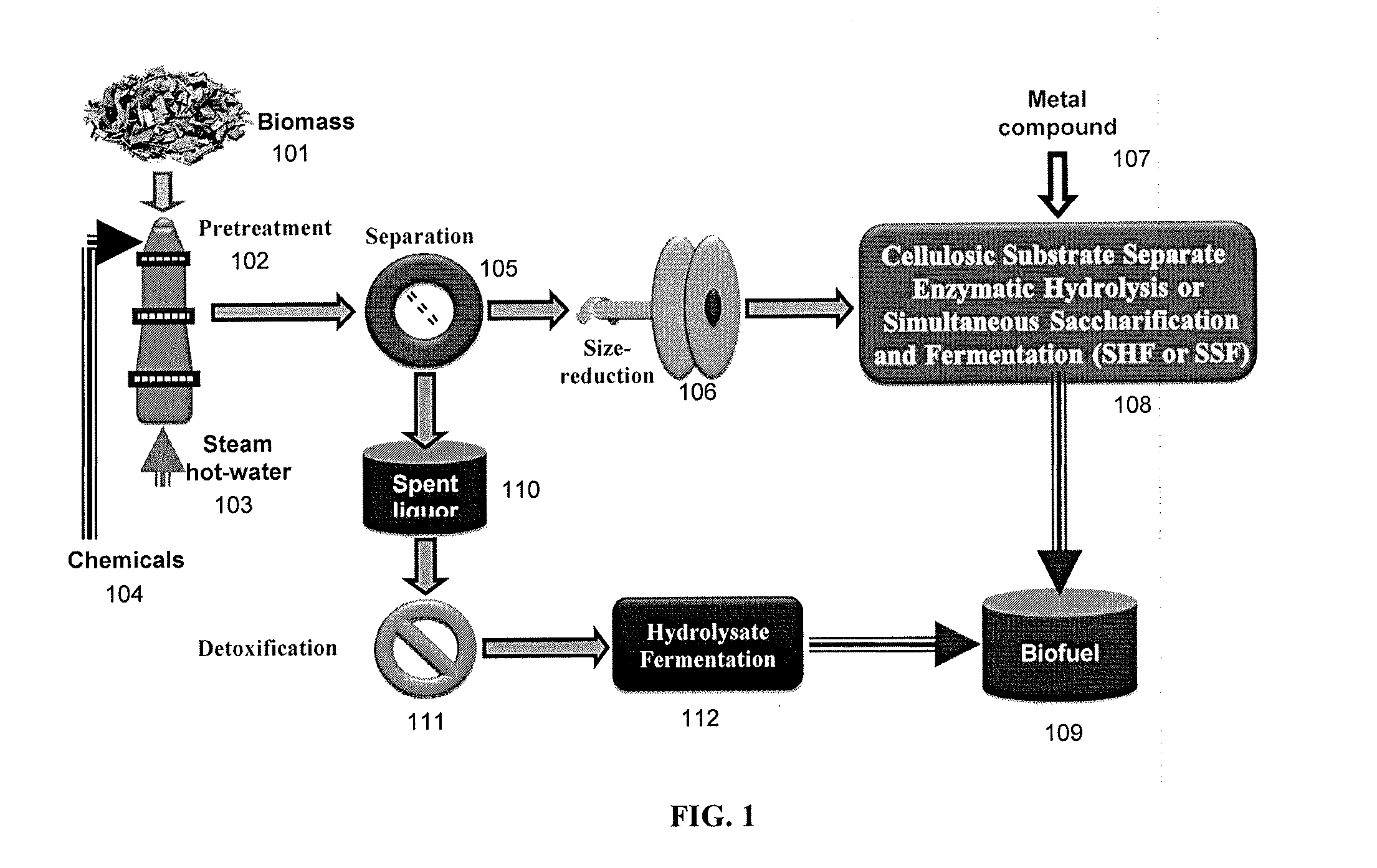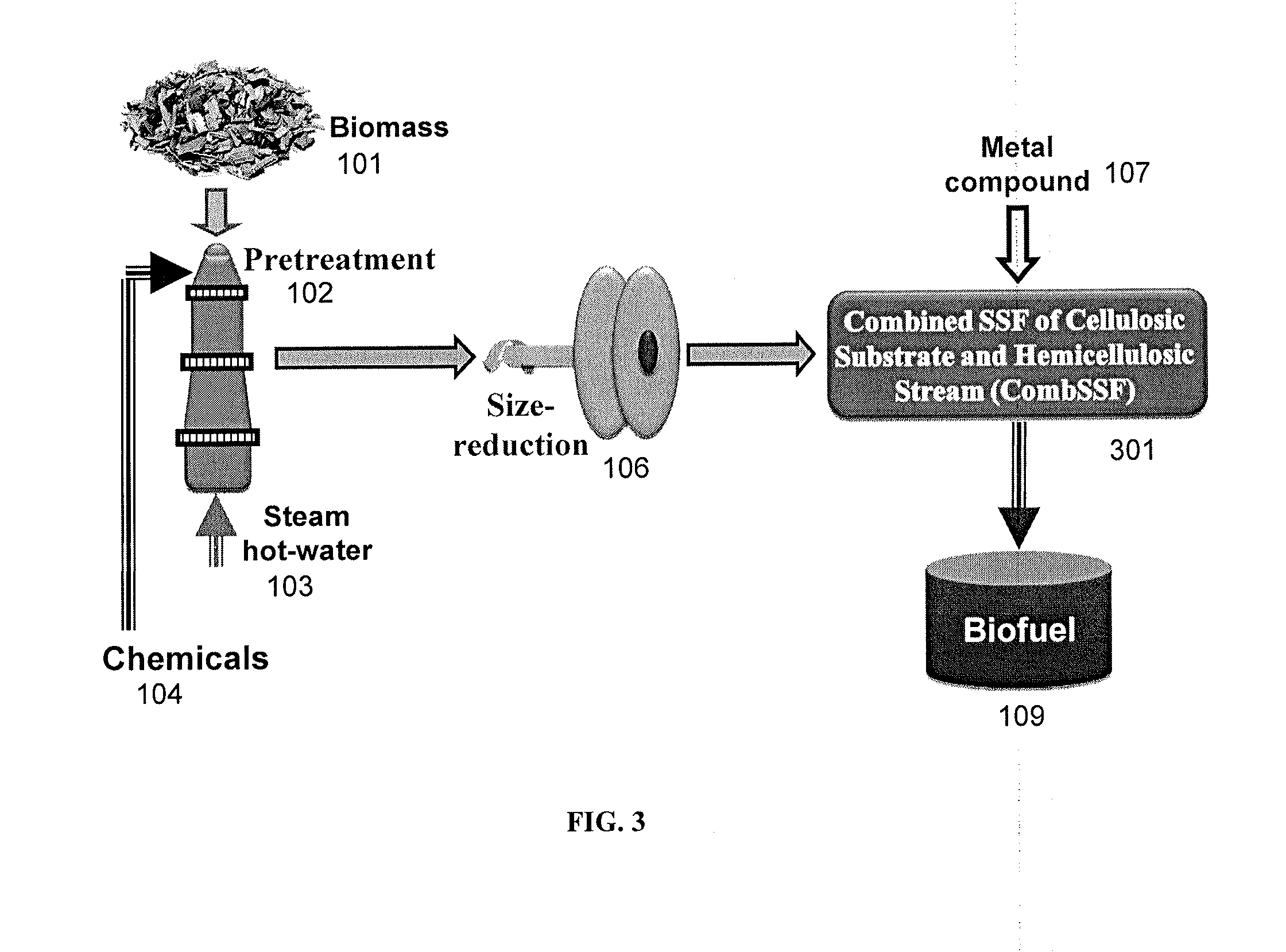Metal Compounds to Eliminate Nonproductive Enzyme Adsorption and Enhance Enzymatic Saccharification of Lignocellulose
a technology of lignocellulose and metal compounds, which is applied in the field of metal compounds to enhance enzymatic hydrolysis of biomass materials, can solve problems such as saving energy and costs, and achieve the effect of enhancing enzymatic hydrolysis and simplifying and improving
- Summary
- Abstract
- Description
- Claims
- Application Information
AI Technical Summary
Benefits of technology
Problems solved by technology
Method used
Image
Examples
example 1
Materials and Methods
[0130]Materials. Two types of solid substrates were used in Examples 2-5: pure cellulose and lignocelluloses from pretreated eucalyptus wood. Whatman Quantitative Filter Paper (Grade No. 41, Whatman, England; ash content <0.01) was defibrated for 8000 revolutions using a disintegrator (TMI, Ronkonkoma, N.Y.) to produce pure cellulosic substrate. Eucalyptus wood chips were screened to remove particles smaller than 6 mm and larger than 38 mm. The accepted wood chips have thickness ranging from 3-8 mm and were subjected to hot-water, dilute-acid, and two SPORL (Sulfite Pretreatment to Overcome Recalcitrance of Lignocellulose) pretreatments and then disk-milled to produce lignocellulosic solid substrates as described in the previous studies (Zhu et al., 2009; Zhu et al., 2010). All pretreatments were conducted at 180° C. with a liquid to wood ratio (L / W) of 3 for a fixed pretreatment duration time of 30 min. An extensive washing using deionized water was applied to ...
example 2
Inhibition of the Enzymatic Hydrolysis of Pure Cellulose by Unbound Lignin
[0143]A few studies reported the inhibition of cellulase by unbound lignin (Sewalt et al., 1997; Berlin et al., 2005) which can be simulated by the purified lignin spiked into cellulose suspension systems. When lignin (SL) was added into pure cellulose (Whatman filter paper) suspensions at a concentration of 0.1 g / L, the substrate cellulose saccharification efficiency was decreased as reflected by the substrate cellulose digestibility (SED) (FIG. 4). SED is defined as the percentage of glucan in substrate converted to glucose by the enzymes. Time-dependent data from duplicate hydrolysis experiments of the control (no lignin addition) and with LS addition are shown in FIG. 4, which demonstrates good experimental repeatability was obtained with only a small systematic error (about 4%) at each sampling point. The duplicate experiments were conducted two weeks apart. So, the systematic errors were most likely from...
example 3
Calcium(II) to Reduce Inhibition of Enzymatic Cellulose Hydrolysis by Unbound Lignin
[0148]It is hypothesized that lignin-metal complexes can reduce nonproductive enzyme adsorption in aqueous cellulose-enzyme systems. Different amounts of CaCl2 were added into the pure cellulose suspensions that contained 0.1 g / L lignin (OL, KL, or SL) before enzymatic hydrolysis. It was found that CaCl2 has no effect on enzymatic hydrolysis of pure cellulose without the addition of lignin (FIG. 7). The slight reduction of about 1% in saccharification efficiency at Ca(II) concentration of 10 mM is within the measurement uncertainty. When CaCl2 was added into lignin containing cellulose suspensions, the recoveries of SEDs are obvious (FIG. 7). With the addition of Ca(II) to a concentration of just 1 mM, 50% or more of the reduction in cellulose saccharification caused by lignin addition was recovered for all the lignin-containing cellulose suspensions. The reduction in SED due to lignin addition was a...
PUM
| Property | Measurement | Unit |
|---|---|---|
| temperature | aaaaa | aaaaa |
| temperature | aaaaa | aaaaa |
| temperature | aaaaa | aaaaa |
Abstract
Description
Claims
Application Information
 Login to View More
Login to View More - R&D
- Intellectual Property
- Life Sciences
- Materials
- Tech Scout
- Unparalleled Data Quality
- Higher Quality Content
- 60% Fewer Hallucinations
Browse by: Latest US Patents, China's latest patents, Technical Efficacy Thesaurus, Application Domain, Technology Topic, Popular Technical Reports.
© 2025 PatSnap. All rights reserved.Legal|Privacy policy|Modern Slavery Act Transparency Statement|Sitemap|About US| Contact US: help@patsnap.com



